![]()

Pic
credit: Rodney Hale/Andrew Collins.
Göbekli Tepe and the Rebirth of Sirius
An examination of the night sky during the epoch of Göbekli Tepe's construction shows that the star Sirius was completely unsuitable for star alignments at this time.
Andrew
Collins* and Rodney Hale**
Summary: Göbekli Tepe is the site of a series of stone enclosures built during the tenth and ninth millennia BC on an isolated mountaintop in southeast Anatolia (Turkish Asia Minor). Speculation has mounted regarding their orientation towards stellar objects, with Orion and Cygnus having already been proposed. Sirius is the latest star to be put forward as the primary focus of key monuments at the site. Yet such a conclusion is thwart with problems, not only in connection with the faint appearance and feeble movement of the star during the epoch in question, c. 9500-9000 BC, but also with respect to the orientation and layout of the enclosures themselves. Instead of being orientated to the south, the direction of Sirius, the enclosures are more likely directed to the north, the direction of liminal activities since the Upper Paleolithic age. In this respect, a more suitable stellar candidate for the orientation of the enclosures is Deneb, the brightest star in Cygnus, which marks the opening of the Milky Way's Dark Rift, seen universally in the past as an entrance to the sky-world.
Key words: Archaeoastronomy, Giulio Magli, Göbekli Tepe, Pre-Pottery Neolithic, Sirius, Cygnus, Orion, Hallan Çemi, Upper Paleolithic, liminal activities, polar stellar tradition, Milky Way, Dark Rift.
*Author of From the Ashes of Angels (1996), The Cygnus Mystery (2006) and Göbekli Tepe: Genesis of the Gods, upcoming 2014. **Chartered engineer MIET.
To download a full PDF version of this article click here
Göbekli
Tepe is perhaps the most enigmatic discovery
in archaeology this century-a series of megalithic structures constructed
during the tenth and ninth millennia BC by a hunter-gatherer society on an isolated
mountain ridge at the western termination of the Ante-Taurus range in southeast
Anatolia (37.2083° N, 38.9167° E).
Two
types of structure are seen, one evolving from the other. The earliest enclosures,
built most probably c. 9500-9000 BC, are composed of twin monoliths with T-shaped
terminations, which have been set up parallel to each other. Around them are circles,
or more correctly ellipses, of slightly smaller, radially positioned standing
stones, which are also T-shaped in appearance. These are placed in stonewalls,
often with stone benches between them.
A number of standing stones at Göbekli
Tepe have clear anthropomorphic features, with many showing carved reliefs, some
in 3D, of fearsome creatures, including lions, foxes, boars, snakes, cranes, vultures,
aurochs, caprids, scorpions, insects and arachnids.
Later structures, built
c. 8500-8000 BC and much smaller in size, also have T-shaped pillars. Yet here
the twin central pillars are replaced by twin stones that stand parallel to each
other, like doorways into a holy of holies.
Astronomical Targets
Even
though the sheer variety of enclosures present at Göbekli Tepe prevents a
single solution to their overall purpose and function, the parallel alignment
of the twin central monoliths has prompted speculation regarding their alignment
to celestial objects, a possibility the site's lead archaeologist Professor Klaus
Schmidt of the German Archaeological Institute (DAI) does not dismiss out of hand
(personal communication with Andrew Collins, September 2013).
So far stars
proposed as aligning with Göbekli Tepe's twin central pillars include the
three stars of Orion's belt in the southern sky (Schoch, 2012), and Deneb, the
brightest star in Cygnus, in the northern sky (Collins, 2006, 2013 & upcoming
2014). However, there is a new contender. Sirius, the fourth brightest object
in the heavens (after the Sun, Moon and Venus) is the latest star to be put forward
as the focus of the Göbekli builders.
Italian
archaeoastronomer Giulio Magli proposes that the twin central pillars in three
Gobekli enclosures-B, C, and D-targeted the rising of Sirius between the dates
9100-8250 BC (Magli, 2013). He points out that around 9300 BC Sirius began appearing
low on the south horizon having been invisible from the latitude of Göbekli
Tepe since c. 15,000 BC. The sight of this new "guest" star perhaps
motivated the Proto-Neolithic peoples of southeast Turkey to create Göbekli
Tepe.
Magli finds "unconvincing" other proposed stellar targets
for the monuments at Göbekli Tepe. Possible alignments towards the rising
of Orion's three belt stars are dismissed, since this would lead to "too
low dating for the structures", while similar alignments to Deneb are also
given short shrift. In Magli's opinion a northern orientation of the Göbekli
monuments is "unnatural as the enclosures are rather open to the south-east."
Atmospheric
Extinction
The
biggest drawback with Sirius' use as a stellar target so soon after its reappearance
on the southern horizon is that it would have been barely visible, its usual bright
magnitude diminished greatly due to atmospheric extinction. A star's loss of brightness
is affected by many factors, including water vapour, dust particles and height
above sea level. Even in a clear sky with negligible pollution these effects can
be severe. In addition to this, atmospheric extinction causes a star's colour
to change. It becomes reddened and even less visible to the naked eye.
This
loss of brightness is measured by the apparent change of the star's magnitude.
Astronomical tables for average losses of brightness are given (Green, 1992).
Based on observations made at a height above sea level of 500m, a star at an altitude
of 5° loses 2.5 magnitudes. At an altitude of 1° it loses about 6 magnitudes,
and actually on the horizon it loses over 9 magnitudes.
Sirius
has a magnitude of -1.46°, so at 5° altitude it becomes magnitude 1, which
is still bright. Yet at 1° altitude it becomes magnitude 4.5, which is extremely
dim. At 0.5° altitude, the height at which Magli proposes the Göbekli
builders targeted their monuments towards Sirius, the star possessed a magnitude
of 6, which is at the very limits of naked eye visibility. This would have been
the manner of its appearance for hundreds of years after its reemergence as early
as 9500 BC. Under any normal circumstances such an insignificant sight cannot
have moved an entire hunter-gathering culture to give up their old lifestyle and
start building the first monumental architecture in human history.
These
facts are expressed in the illustrations that accompany this article. Fig. 1 shows
Sirius at an altitude of 0.5° for a date of 9100BC (courtesy of Stellarium
software which incorporates atmospheric effects). Sirius is just a faint spot
(magnitude 4.87) compared with, say, Orion's belt stars immediately above it.
Clearly, Sirius rising appears totally insignificant during this period, for even
at an altitude of 2° as seen in Fig. 2 it has a magnitude of just 2.3, which
would have made it little different to any other star in the sky.

Fig.1. Sirius at half a degree altitude in 9100 BC showing its relative brightness to other stars (Credit: Stellarium).
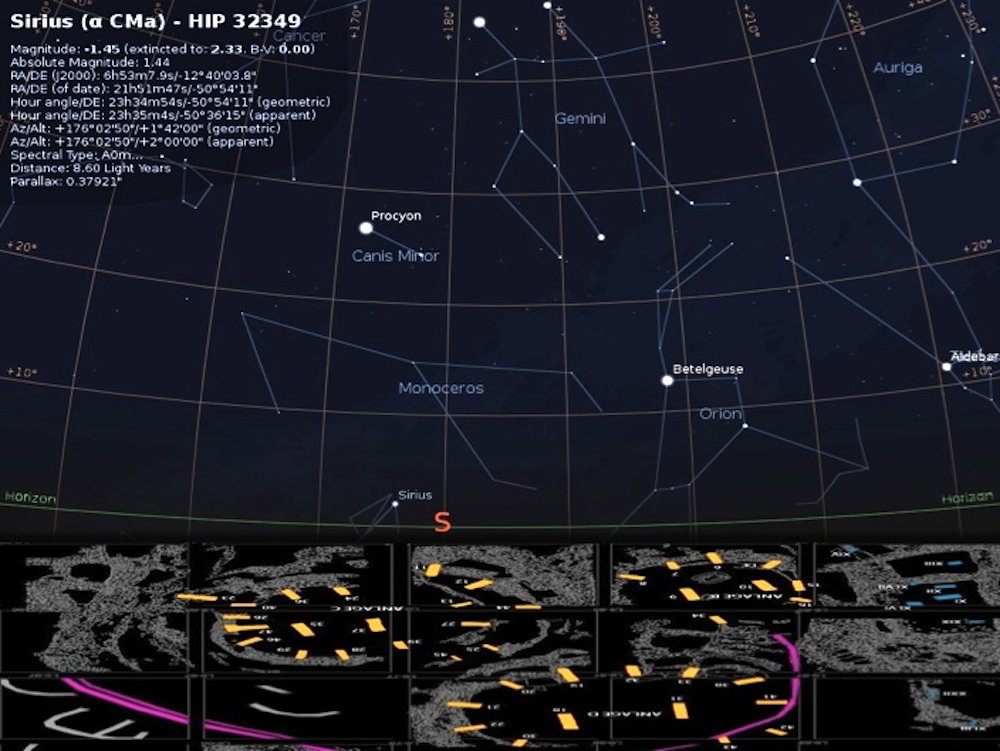
Fig. 2. Sirius at 2° altitude
in 8950 BC showing its relative brightness to other stars (Credit: Stellarium).
Atmospheric
Refraction
Another
problem is atmospheric refraction, which Magli makes no reference to in his paper.
He doesn't tell us whether it has or has not been taken into account, leaving
some doubt over his Sirius azimuth figures. When altitudes as low as half a degree
are employed for alignment purposes, refraction will raise the apparent altitude
of a star by around half a degree, necessitating an adjustment to any proposed
azimuth figures.
Until further details emerge this uncertainty must be borne in mind as we examine Magli's proposed mean azimuths for the twin central pillars of the enclosures involved, and the corresponding dates at which they target the rising of Sirius:
Enclosure
D 172° 9100 BC
Enclosure C 165° 8750 BC
Enclosure B 159° 8300
BC
Not
only do these dates reflect the monuments' approximate epoch of construction,
but they also show very clearly that the twin pillars target a single star as
it gradually shifts its rising or setting position on the local horizon due to
the effects of precession (a point previously noted by both Schoch and the current
authors). This is caused by the slow wobble of the earth against the stellar background
across a cycle of nearly 26,000 years.
Frustratingly, Magli's mean azimuths for two of the enclosures differ from those suggested by the DAI's site plan. When all these factors are taken into account a slightly different correlation is revealed between the mean azimuths of the twin pillars and the rising of Sirius at a height of half a degree:
Enclosure
D 173° 9400 BC
Enclosure C 165° 8950 BC
Enclosure B 157° 8275
BC
As can be seen from these revised figures (and from Fig. 3), in two instances the correlation date between Sirius rising and the alignment of the pillars has been shifted back hundreds of years, even though this adds little to Magli's theory. For instance, in 9400 BC when the twin pillars of Enclosure D would have aligned with the rising of Sirius at half a degree (with refraction taken into account), the star would still have been barely visible to the naked eye as it crawled along the horizon (see Fig. 4).
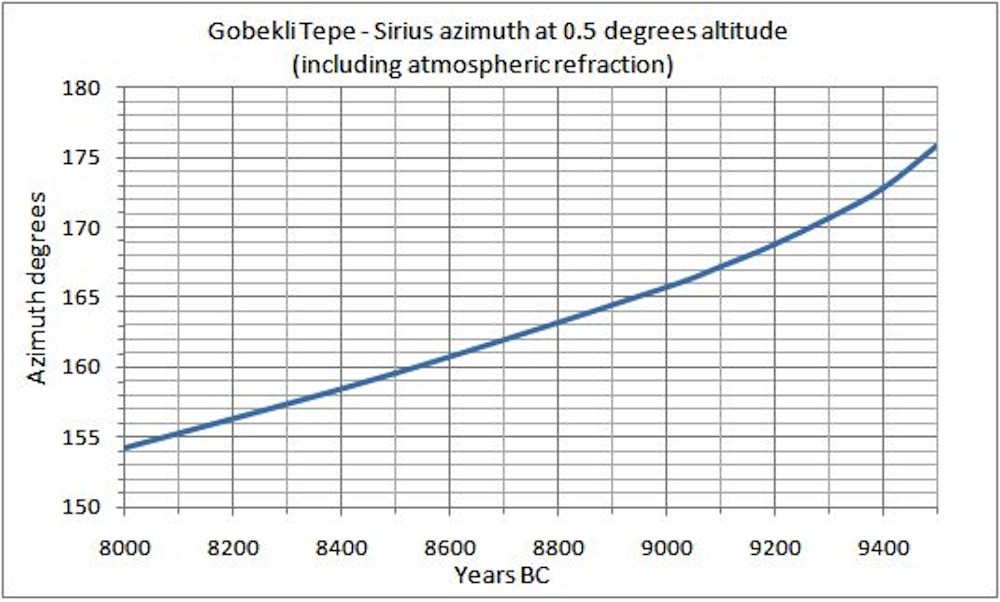
Fig.
3. The rising of Sirius based on an altitude of half a degree including atmospheric
refraction from its first reappearance in around 9500 BC through till 8000 BC
(Credit: Rodney Hale).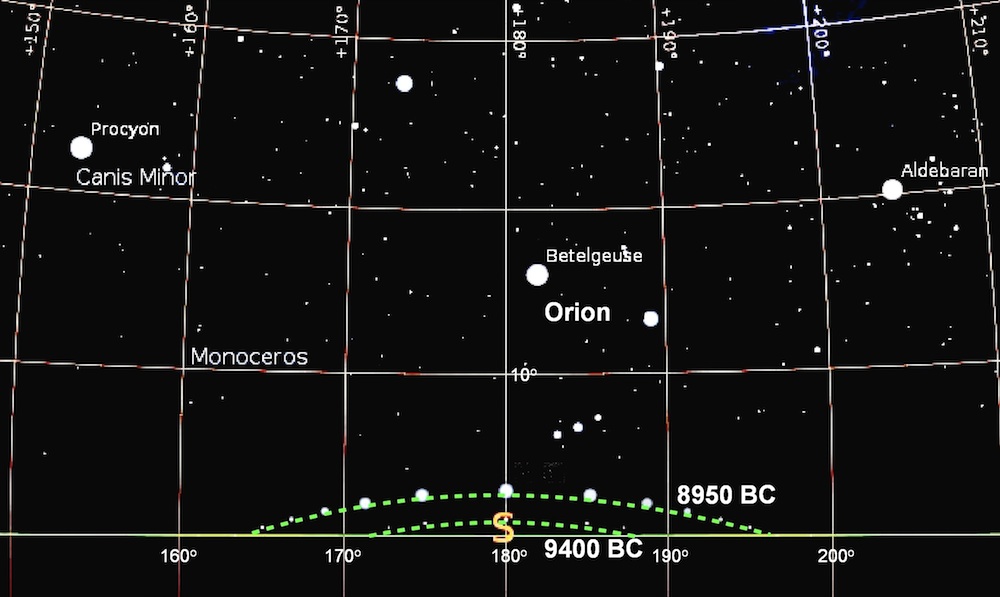
Fig.
4. The path across the southern horizon of Sirius on the dates 9400 BC and 8950
BC showing its brightness relative to other key stars of the southern sky (Credit:
Rodney Hale/Stellarium).
By
8950 BC when Enclosure C's twin pillars targeted Sirius, the star would still
have been faint as it moved across the horizon. Yet here, in Enclosure C, there
is an added problem. The star would not have been seen from the position of the
twin central pillars, as a rocky slope to the south partially obscures the view.
Excavations in 2012 uncovered a staircase cut into the slope for use by entrants
approaching from the south (Dietrich, 2013).
Around
8275 BC, when the central pillars of Enclosure B targeted the rising of Sirius,
the star climbed to make a much more appreciable arc, reaching a maximum elevation
of 6° as it crossed the meridian, due south. Despite this encouraging fact,
we now come into massive dating issues. Bone samples taken from Enclosure B have
provided radiocarbon dates in the range of 8306-8236 BC (Schmidt and Dietrich,
2010), around the same time that its twin pillars targeted Sirius at an altitude
of half a degree. Yet according to the excavators these human remains may well
derive from an intrusive burial made long after the structure's construction.
Indeed, since Enclosure B is built on the plateau's bedrock next to Enclosures
C and D, the chances are all three are roughly contemporaneous, meaning that Enclosure
B was most probably in existence by around 9000 BC. If so, then its twin central
pillars cannot have been built to target the rising of Sirius in 8250 BC.
It
might be proposed that instead of using an altitude of half a degree as the rising
of Sirius, why not use either 1° or, preferably, 2°, when the star would
have gained a slightly better magnitude. This could be done, although because
the star will have moved sufficiently by the time it reaches these greater magnitudes
it creates correlation dates much younger than those proposed here, perhaps by
as much as a thousand years. Then the same problems that caused Magli to discount
Orion as a stellar target at Göbekli Tepe would apply, for as he suggests,
it would mean "too low dating for the structures".
North not South
Next
we examine Giulio Magli's premise, necessary for his theory, that Göbekli
Tepe's main enclosures are open to the south, enabling the light from Sirius to
enter their interiors in a manner found in connection with later megalithic monuments
worldwide.
Despite
overwhelming evidence to show that many megalithic structures were indeed designed
to allow the light of celestial objects to penetrate their interiors (Newgrange
in Ireland's Boyne Valley being the prime example), there is no reason to assume
the monuments of Göbekli Tepe, built several thousand years earlier, formed
part of this same tradition. Its curvilinear structures seem to represent a supersizing
of cult shrines that already existed throughout the Near East.
These early
Neolithic structures seem to be the product of a much older tradition lingering
from the Upper Palaeolithic age, where the entrances to caves and rock shelters
used both for habitation and cultic purposes were, whenever possible, south-facing
in perspective. In this manner they enjoyed maximum exposure to solar radiation,
i.e. sunlight, and thus experienced warmer temperatures all the year round. It
also permitted shelter from cold harsh winds coming from the north. This preferred
utilisation of caves and rock shelters with south-facing entrances was employed
by the Solutrean culture of France and Spain, c. 22,000-17,000 years ago (Straus,
1979), and later by the Magdalenian peoples, c. 17,000-11,000 years ago (Jochim,
2011, 103). Such ideas were prevalent even among the Neanderthal peoples of the
Middle Paleolithic, c. 40,000-100,000 years ago (Mellars, 1996, 249).
Over
the course of many thousands of years, the south (as the direction of the cave
entrances) most likely became associated with life, light, human habitation and,
by virtue of this, the mundane world. East, as the place of the rising sun, became
the direction of new life, while the west became the direction of death, as it
was here the sun died each day. This left the north which, since it did not provide
sunlight, was viewed as the direction of darkness, liminal activities, as well
as the turning point of the heavens, the origin perhaps of polar based sky-religions
in the northern hemisphere.
Built
on the Bedrock
Enclosures A, B, C, D and E were all built on the mountain bedrock with uninterrupted views of the local horizon (although, as we have seen, Enclosure's C view of the southern horizon is at least partially obscured by a rising slope-see Fig. 5). In time these primary enclosures were decommissioned and covered over by a gradually emerging occupational mound or tell, constructed from imported soil, stone chippings, and general refuse including faunal remains and some human remains.
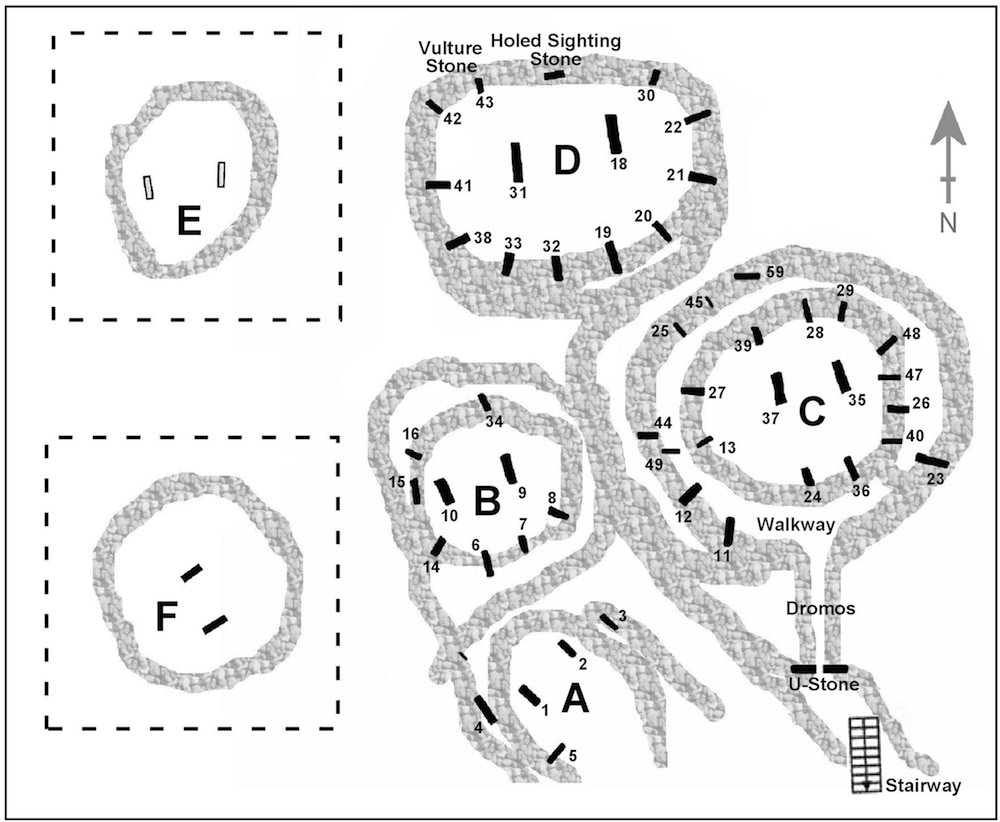
Fig.
5. Plan of Göbekli Tepe showing the stairway discovered in 2012 (Credit:
Rodney Hale).
Later
structures were built either into the slopes of the gradually emerging tell, or
directly on top of it. It was an organic process that continued through until
the final abandonment of the site around 8000 BC, when any remaining structures
were covered over, leaving behind a perfectly rounded, belly-like hill completely
artificial in nature.
The fact that the main enclosures uncovered so far
are grouped together in the southeast section of the occupational mound has given
rise to the false assumption that they are, as Magli states, "open to the
south-east". Yet as we can see, this is simply not so, and, if Enclosure
C is anything to go by, the more likely scenario is that they were directed towards
the north, the direction of liminal activities since the Paleolithic age.
True
Orientations
This
directional preference appears to have been adopted from existing cult shrines
of the Proto-Neolithic age. For instance, at Hallan Çemi, a site in the
Eastern Taurus Mountains of eastern Turkey, two circular buildings were uncovered,
dating to c. 10,250-9600 BC. Stone benches lined their interior walls, with hearths
at their centres (Rosenberg, 1999; Peasnall & Dyson, 2002).
At the
northern end of one of these cult shrines, a huge auroch's skull was found. It
had hung on the wall, a central focus for all those who sat within its interior.
The deliberate placement of this enormous bucranium within the cult shrine at
Hallan Çemi prompted ethnoarchaeologist Brian Hayden to comment:
It seems clear that this is a prototype of ritual structures that are to be found in more elaborate forms several hundred years later at Jerf el Ahmar (in northern Syria) and Mureybet (on the Middle Euphrates, also in Syria) in village contexts and perhaps even Çatal Höyük, where bucrania preferentially adorned the north walls (Hayden, 2003, 207).
As
Hayden infers, the north was the primary direction of orientation of Proto-Neolithic
and later Neolithic cult structures right down to the time of Çatal Höyük.
Since Hallan Çemi was almost certainly a precursor to Göbekli Tepe,
which lies some 225 km to the southwest, it very likely influenced the style and
design of the monuments there, including their northerly orientations.
If
this is the case, it is a highly significant realisation, for Hallan Çemi's
cult shrines were constructed many hundreds of years before the reappearance of
Sirius on the southern horizon, showing that this star is extremely unlikely to
have played a role in the orientation of the monuments at Göbekli Tepe. Much
more likely is that its enclosures were orientated towards the north in its capacity
as the direction of liminal activities and supernatural agencies. In this manner,
entrants wishing to commune with these supernatural agencies would approach the
structure's twin central pillars from the south in order to access the otherworldly
realms thought to exist beyond them to the north, the direction not only of the
celestial pole, but also of the circumpolar stars, i.e. those that never set below
the horizon.
Turning
to Cygnus
If
the twin central pillars in the main enclosures at Göbekli Tepe are aligned
to a celestial object the chances are it was a near circumpolar star, i.e. one
that rose on the north-northeast horizon, arced over the celestial pole on its
upper transit, and then set on the north-northwestern horizon as it reached the
climax of its lower transit.
An
examination by the authors of the mean azimuths of the twin central pillars in
three enclosures-C, D and E-shows a precise correlation with Deneb, the brightest
star in the constellation of Cygnus in the epoch c. 9400-8900 BC. The star's setting
(not its rising as Magli states) on the north-northwestern horizon would have
been fully visible to the Pre-Pottery Neolithic peoples of Göbekli Tepe right
down to an altitude of 2°, when it would have finally faded from view.
The
reason perhaps for Deneb being chosen for this purpose lies in the fact that it
marks the opening of the Milky Way's Dark Rift, known also as the Cygnus Rift.
This is a darkened area running down the centre of the Milky Way caused by the
presence of stellar debris. The Dark Rift stretches from Cygnus all the way to
the stars of Sagittarius and Scorpius, precisely where the ecliptic, the sun's
path, crosses the Milky Way. Globally, the Dark Rift has been seen as an entrance
to the sky-world, as well as a place of the afterlife (Collins, 2006, and Collins,
upcoming 2014).
Key
Stones
Göbekli
Tepe's Pillar 43 in Enclosure D shows a vulture with wings articulated in a manner
that gives the bird the appearance of Cygnus (Vahradyane and Vahradyane, 2010
and see Fig. 6), while below it is a scorpion identified as a possible representation
of Scorpius (Belmonte, 2010).
That these two constellations located at the
top and bottom of the Milky Way's Dark Rift are shown together on one stone seems
beyond chance, especially as in the second half of the tenth millennium BC when
the stars of Scorpius were visible just above the western horizon the stars of
Cygnus would be crossing the meridian, due north (see Fig. 7).
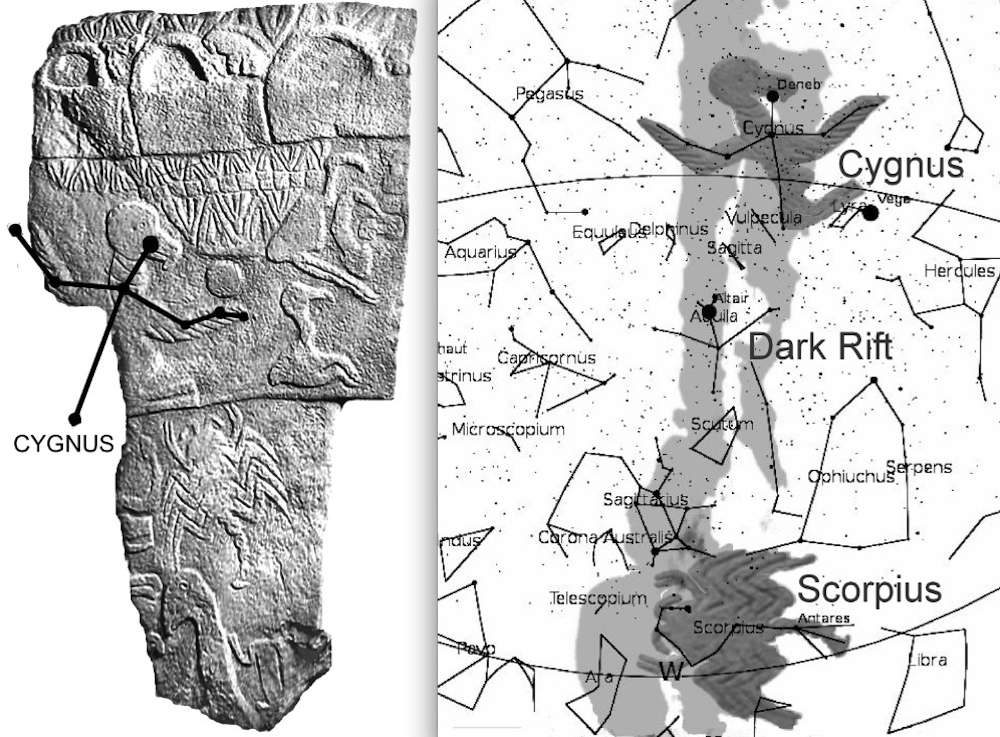
Fig.
6, left. Göbekli Tepe's Pillar 43 in Enclosure D with Cygnus overlaid on
its vulture carving (Credit: Rodney Hale). Fig. 7, right. Pillar 43's vulture
and scorpion overlaid on the Dark Rift as seen c. 9400 BC (Credit: Rodney Hale).
Further confirmation of Enclosure D's alignment to Cygnus was the recent discovery immediately to the east of Pillar 43 of a large holed stone that stands erect within the north-northwestern section of the perimeter wall. In contrast to the radially aligned pillars in the various enclosures, this holed stone has its widest face facing towards the twin central pillars. Anyone standing or crouching between these huge monoliths in c. 9400 BC, the approximate date of construction of the enclosure according to available radiocarbon evidence (Schmidt and Dietrich, 2010), could have peered through this hole to watch the setting of Deneb (see Fig. 8). The fact that carved imagery on the holed stone might well represent an abstract female form, the opening as her vulva, expresses a symbolic act in which Deneb and the entrance to the Dark Rift are recognised as the direction of new life entering the enclosure's interior from the starry realms to the north.

Fig. 8. Plan of Enclosure D showing the position of Pillar 43 and the holed stone in the NNW section of the perimeter wall. The arrow indicates the setting of Deneb in 9400 BC (Credit: Rodney Hale).
Here
comes the sun
Only
later did the switch towards other directions occur, most obviously the east,
the direction of the rising sun. Enclosure F (not Enclosure E as Magli states)
has an azimuth of 59°, directing it towards sunrise at the time of the summer
solstice, while the Lion Pillar Building built on top of the tell, as much as
15m above the enclosures situated on the bedrock below, is orientated east-west.
Its eastern end-where twin pillars bearing carved reliefs of rearing lions are
to be seen-is almost certainly directed towards sunrise at the time of the equinoxes.
Its twin lions, which face into the room, are very likely symbols both of the
might of the sun, and arguably the presence of the constellation of Leo, the celestial
lion. This would have risen into the sky immediately prior to the sun at the time
of the spring equinox.
This change of orientation might well have had something
to do with the fact that by this time, c. 8500-8000 BC, the hunter-gatherer society
responsible for the original creation of Göbekli Tepe had now been replaced
by representatives of settled farming communities following the introduction of
subsistence agriculture across southeast Anatolia and the Levant. For the first
time, the sun, in conjunction with the zodiacal constellations positioned along
the line of the ecliptic, was emerging now as a primary influence in the sky-based
beliefs of the Neolithic world.
Conclusions
It
is clear that Sirius is unlikely to have been the primary focus of the earliest
enclosures at Göbekli Tepe, due to its faint appearance and feeble movement
during the epoch of their construction. Moreover, unless peoples from more southerly
climes introduced the Göbekli builders to its greater significance, Sirius
would have been seen as unimportant during the initial phase of construction at
the site. This severely weakens any claims that Göbekli Tepe's twin central
pillars were aligned to target the rising of this star.
On the other hand,
Deneb and the entrance to the Milky Way's Dark Rift, being located in the north,
the direction of liminal activities and otherworldly realms since the Upper Paleolithic,
possessed an incredible symbolic value to the earliest Neolithic peoples of the
Near East. In this manner, Deneb and the Dark Rift fare far better as primary
candidates for the orientation of key monuments at Göbekli Tepe.
Bibliography
Belmonte,
J. A., "Finding Our Place in the Cosmos: The Role of Astronomy In Ancient
Cultures", Journal of Cosmology 9 (2010), 2052-62.
Collins, Andrew,
"Göbekli Tepe: Its Cosmic Blueprint Revealed", 2013, http://www.andrewcollins.com/page/articles/Gobekli.htm.
Collins,
Andrew, The Cygnus Mystery, Watkins, London, 2006.
Collins, Andrew,
Göbekli Tepe: Genesis of the Gods, Bear & Co., Rochester, VM,
upcoming 2014.
Dietrich, Oliver, Çigdem Köksal-Schmidt, Cihat Kürkcüoglu,
Jens Notroff, and Klaus Schmidt, "Göbekli Tepe: A stairway to the circle
of boars", Actual Archaeology 5 (Spring 2013), 30-31.
Green, Daniel
W. E. "Magnitude corrections for atmospheric extinction", International
Comet Quarterly 14 (July 1992), 55-59, http://www.icq.eps.harvard.edu/ICQExtinct.
Jochim,
Michael, in Sarunas Milisauskas, European Prehistory: A Survey, Stringer,
New York, NY, 2011, 67-124.
Magli, Giulio, "Possible astronomical references
in the project of the megalithic enclosures of Göbekli Tepe", http://arxiv.org/abs/1307.8397
[physics.hist-ph].
Mellars, Paul, The Neanderthal Legacy, Princeton Univ.
Press, 1996.
Peasnall, Brian L., and Robert H. Dyson, "Research Notes:
Intricacies of Hallan Çemi", Expedition 44/1 (2002), pp. 5-6.
Rosenberg,
Michael, "Hallan Çemi", in Mehmet Özdogan, and Nezih Basgelen,
eds., Neolithic in Turkey: The Cradle of Civilization: New Discoveries,
Arkeoloji ve Sanat, Istanbul, 1999, 25-33
Schmidt, Klaus, and Oliver Dietrich,
"A Radiocarbon Date from the Wall Plaster of Enclosure D of Göbekli
Tepe" Neo-Lithics 2/10 (2010), 82-83.
Schoch, Robert, Forgotten
Civilization: The Role of Solar Outbursts in Our Past and Future, Inner Traditions,
Rochester, VM, 2012.
Straus, Lawrence Guy, "Cantabria and vascongadas,
21,000-17,000 B.P.: Toward a solutrean settlement pattern", Munibe,
XXX:3-4 (1979), 195-202.
Vahradyane, Vachagan and Marine, "About the Astronomical
Role of 'Qarahunge' Monument", 2010, click
here
![]()
![]()